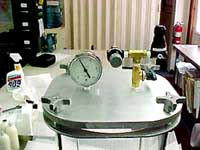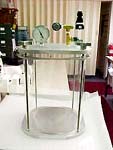Shop for Products by Aero-Tech
- Aerosol Can Validation & Testing Services
- Aerosol Gauges
- Aerosol Lab Safety Equipmet
- Burette Pressure Fillers
- Burette Pressure Filler Accessories
- Calibration Services
- Crimpers
- Crimper Accessories
- Decrimpers
- Decrimper accessories
- Deseamers
- Deseamer Accessories
- Design & Engineering Services
- Diaphragm Seal Assemblies
- Filling Adapters
- Gasser / Shakers
- Hydrostatic Burst Testers
- Lab Accessories
- Machining & Manufacturing Services
- Mid-Scale Packaging Line
- Non Sparking Tools
- Piston Can Fillers
- Pressure Reaction / Compatibility Vessels
- Pressure/Vacuum Testers
- Pressure/Vacuum Tester Accessories
- Product Fillers
- Propellent / Gas Monitoring Systems
- Used Equipment
- Vacuum Crimpers
- Vacuum Crimper Accessories
- Volumetric Propellant Filler
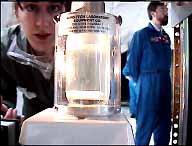
Aero-Tech Case Studies: NASA, John H. Glenn Research Center
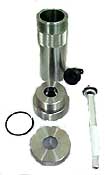
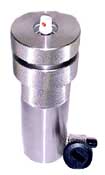
Research Engineer, Edward A. Hovenac, inquired about Aero-Tech's compatibility vessels. He was involved in a project to determine how aerosols behave in a microgravity environments. After seeing the different types we offer, he choose the GK-500 along with the PSGK-500 hand-held Polycarbonate shields.
Project 1: NASA used the GK-500 and PSGK-500 in flight, aboard a KC-135 and had successful experiments. They could see inside the container for the effects of microgravity on the product. Conventional aerosol cans with dip tubes in the containers would not be adequate. With lack of gravity present, the product would not stay at the bottom of the container, therefore not having constant contact with the dip tube.
Project 2: A prototype container using CCL's Advanced Barrier System. This prototype container was made of 303 stainless steel and consisted of four pieces. This time, the product was placed inside the barrier system. The container was then pressurized and NASA had perfect 360-degree dispensing.
Aero-Tech Lab additional Case Studies
Pfizer Health Care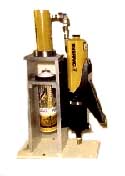
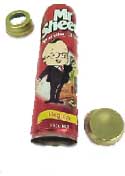
Pfizer Health Care came to Aero-Tech with a problem back in 1996. They wanted to know if their product was compatible with the can after stability testing. A new product was created that increased sales the first year by $27,000.00. In the end, Aero-Tech and Pfizer helped each other. |
Galxo Welcome Company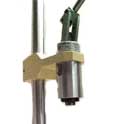
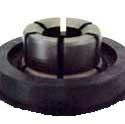
Dr. Mark Sommerville came to Aero-Tech needing to make his own metered-dose valve assemblies. This enabled him to choose the necessary components and precisely control the administered amount. Aero-Tech designed a collet to do the crimping and adapted our bottle crimper to accept the collet. Dr. Sommerville's on-going experiments can now go as planned. |
Clairol Corporation
|
Aero-Tech Customizes Equipment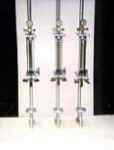
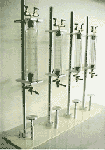
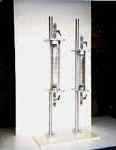
These are examples of custom pressure fillers Aero-Tech made for Colgate and Clorox. Allows for incorporation of multiple burettes to suit specific needs. The price depends on number and size of burettes selected. |
Aero-Tech Products in Space: Courtesy of N.A.S.A.
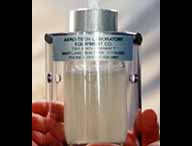
The photographs were taken in flight aboard NASA's KC-135, which simulates a microgravity environment.
Edward A. Hovenac, the engineer in charge of the project, said they had a very successful flight with the
GK-500 pressure reaction compatibility vessels. Experiments concluded that conventional packaging of aerosols
will not behave the same in space.
With no gravity present the product will not stay at the bottom of the container. Therefore, the dip tube can
not make constant contact with the product, making dispensing very inconsistent and inefficient. The vessels
were fitted into the PSGK-500, a polycarbonate hand-held shield made of the same material as bullet proof glass.
Aero-tech is now involved in a second R&D project with NASA to help solve this problem. It involves a product
from Advanced Monobloc, a division of CCL Container, which is the Advanced Barrier System, (ABS) bag in the can
barrier. The outcome of these experiments should greatly differ. Due to the design of this product, it offers
all-attitude, 360-degree dispensing. Aero-tech will post the results of the experiments when concluded. If successful,
the prototype lab equipment that is being used in this experiment will be used on the space station.
In the future, Aero-tech will be continuing to support NASA with R&D laboratory equipment on the ground and on the
International Space Station. We are very proud to participate in this project with NASA.
The Space Station is the largest and most advanced laboratory ever built for research in space. The station will
return scientific, technological, political, and economical benefits to it's International partners; United States,
Russia, Canada, Japan, and certain members of the European Space Agency; Belgium, Denmark, France, Germany, Italy,
Netherlands, Spain, and the United Kingdom.
Aero-Tech Laboratory Equipment Company Products in the News
Aero-Tech featured in Spray Technology Magazine
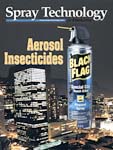
Aero-Tech Laboratories was recently featured in Spray Technology and Marketing Magazine, which has world-wide circulation. The March 1998 issue of Spray Technology magazine was the introduction & review of our Aerosol Can Deseamer. The December 1998 issue was the introduction and review of our Vacuum Crimper. The January 2000 issue was the coverage of the R&D prototype experiment we did for NASA.
Dupont teaches seminars with Aero-Tech Equipment
Dupont, the world's largest supplier of propellants, offers hands-on aerosol seminars with our equipment
to potential customers. At the end of the training seminar, Dupont refers the newly certified
professionals to Aero-Tech for their R&D needs and product formulation.

Aero-Tech Laboratory Equipment Company LLC - New Product Updates
We are happy to introduce the ALT-SP, a new side ported compatibility vessel, now capable of pressure & temperature readings quickly, Also great for observation & stability testing for BOV (bag on valves).
We would also like to introduce ATL-TK, a complete test kit for this new compatibility vessel.
Some of our other new products can be found here: propellant / gas monitoring systems, non-sparking tools, anti-static/ fatigue floor & table mats and personal safety equipment to assure the safest, productive atmosphere and environment.
